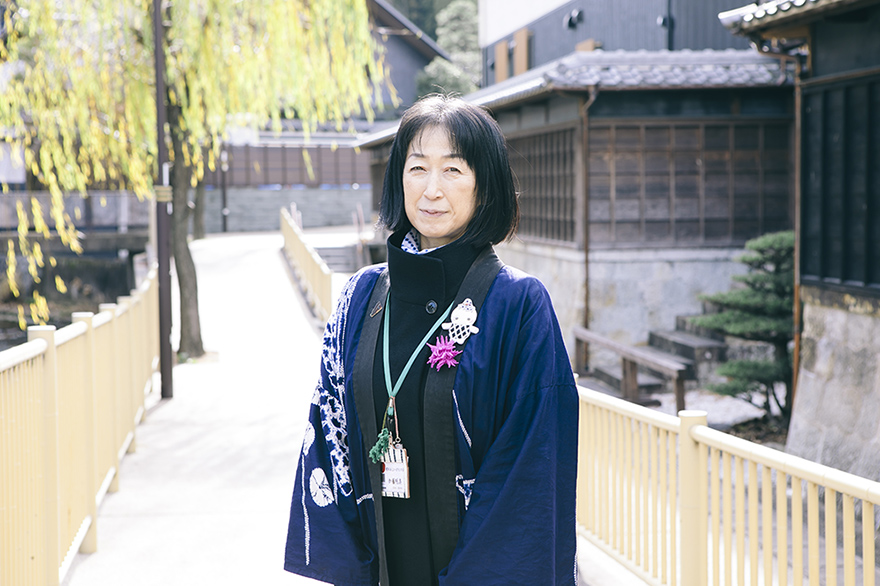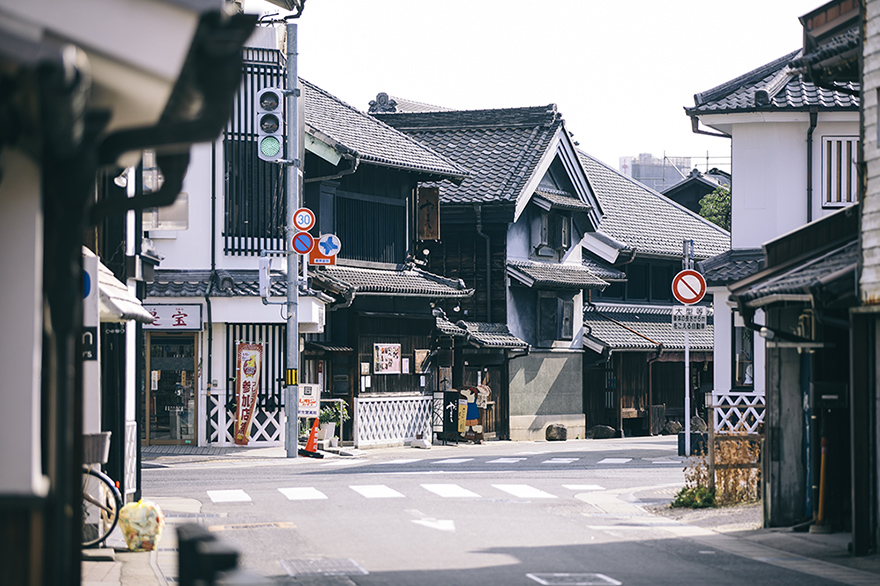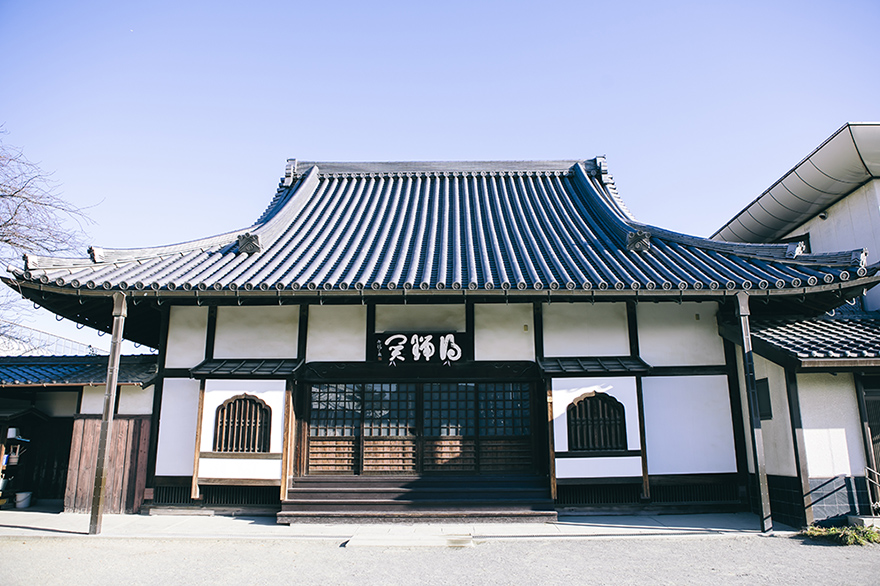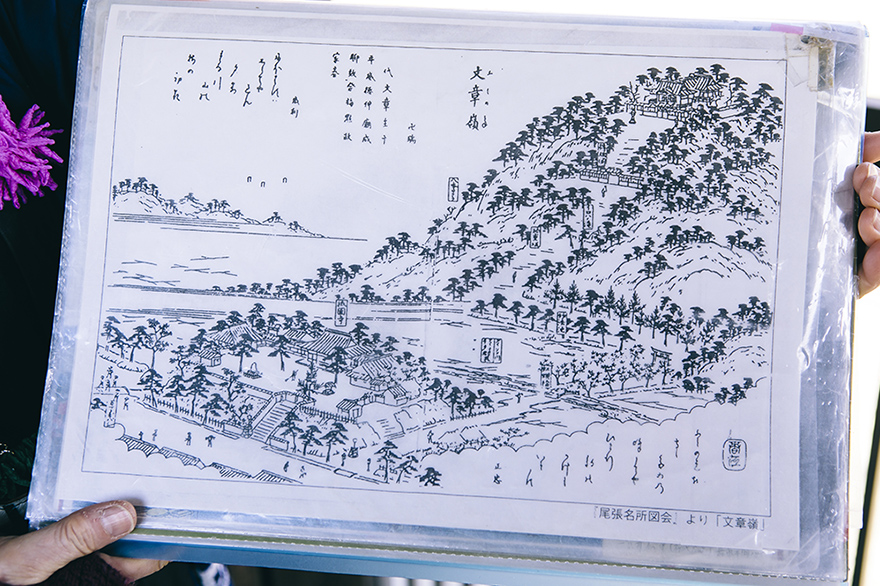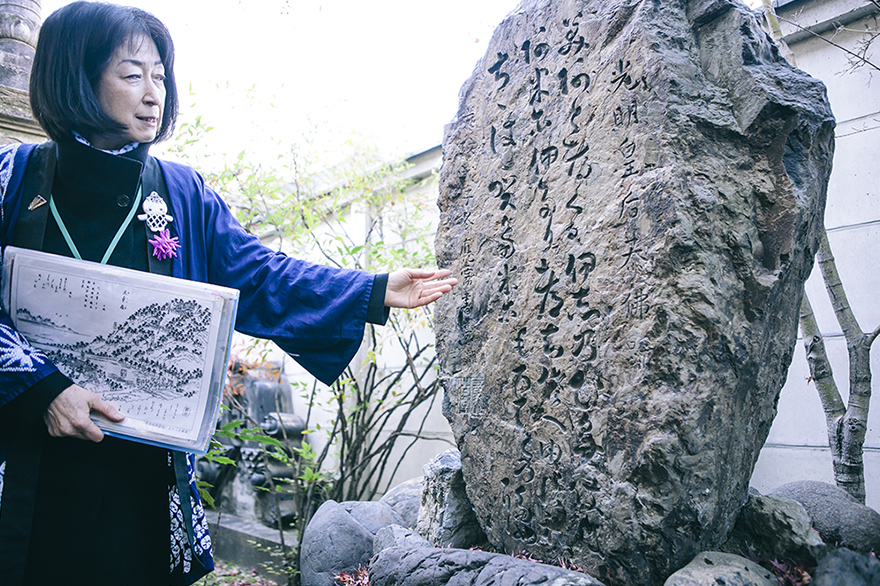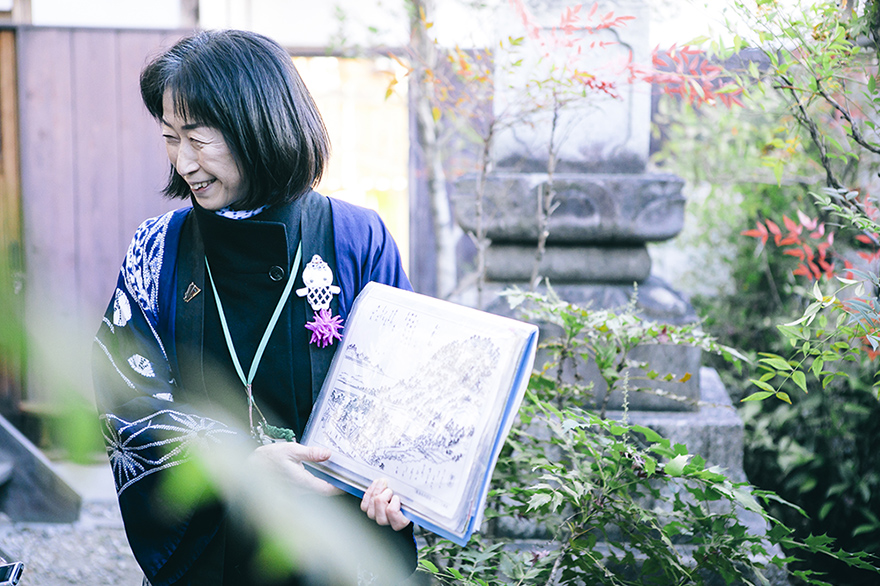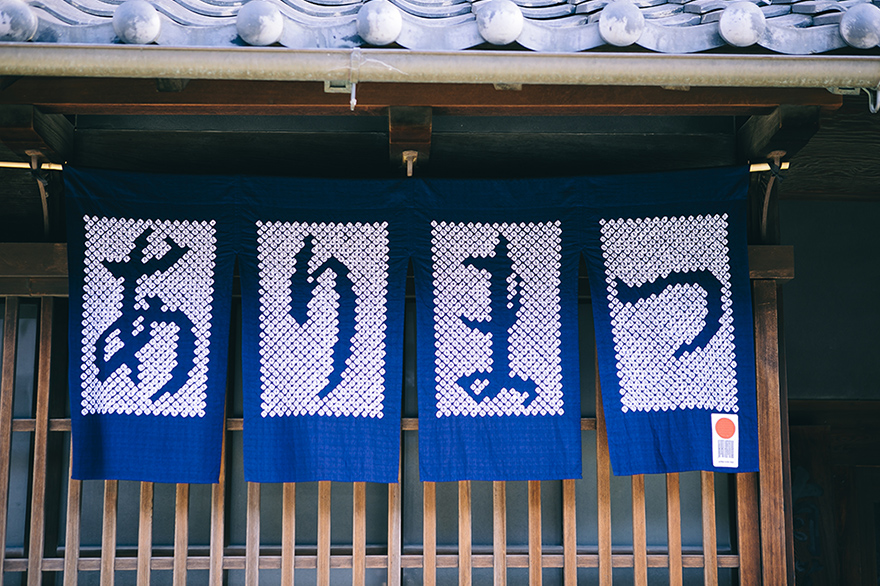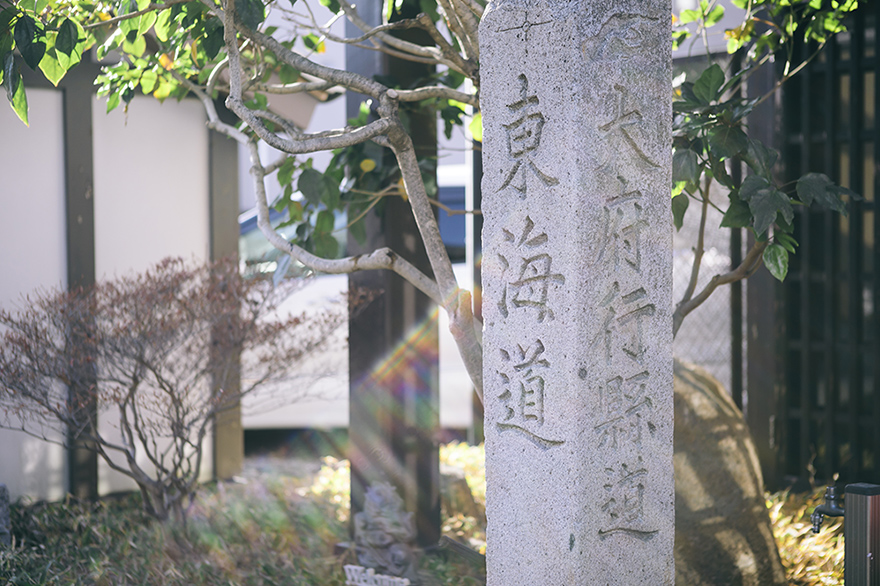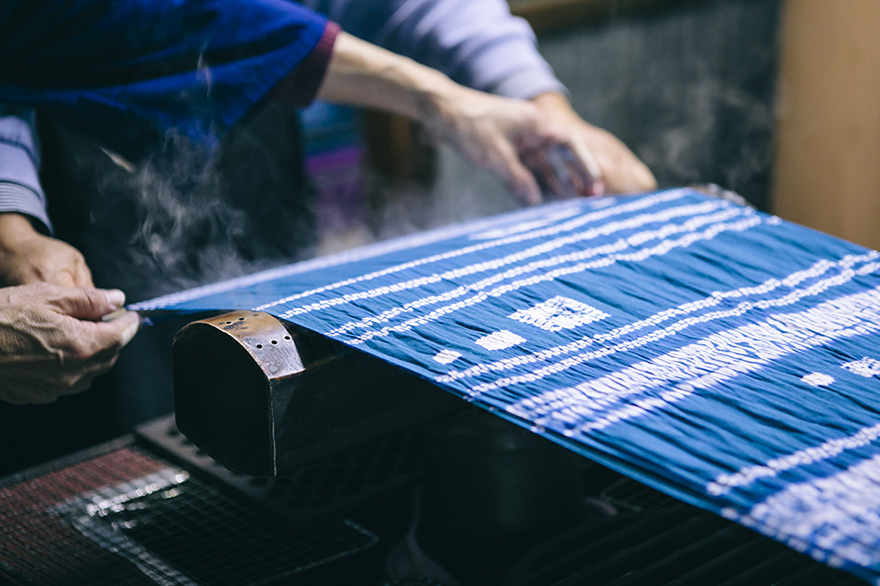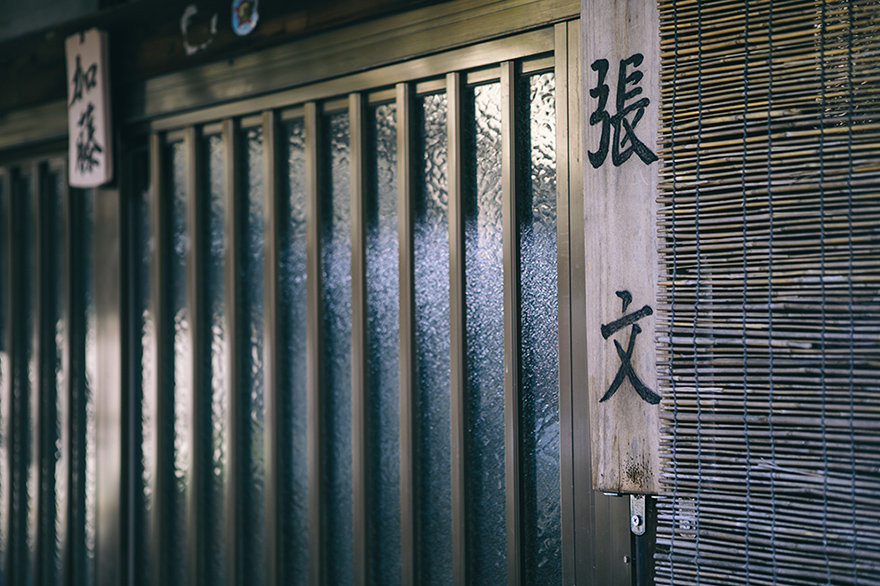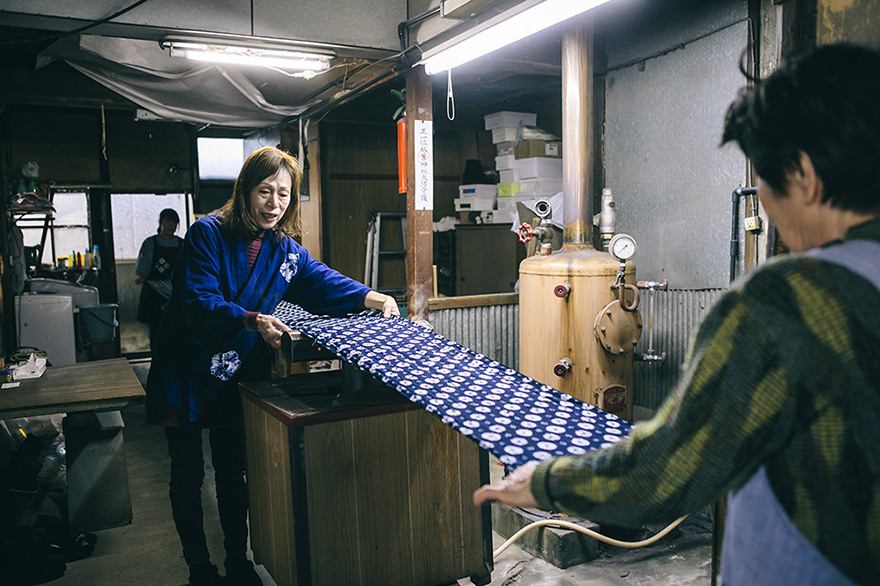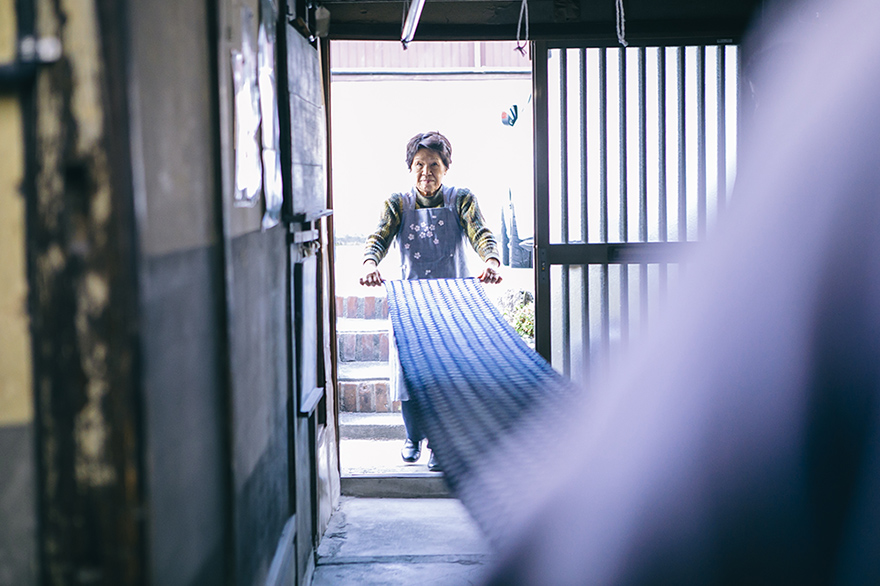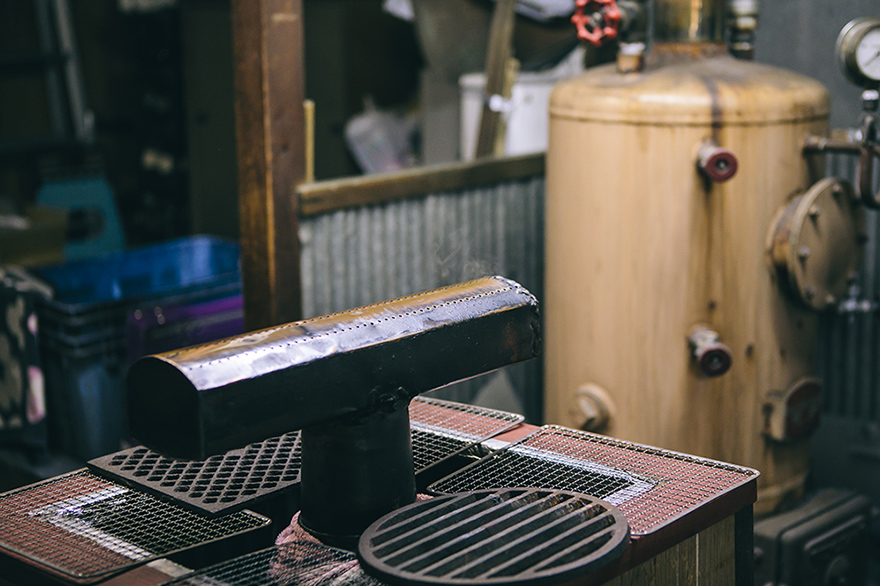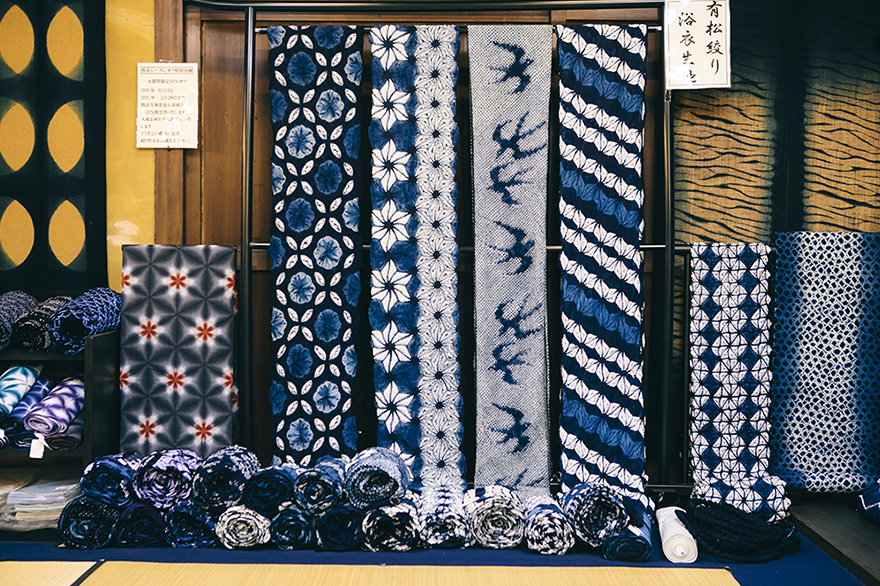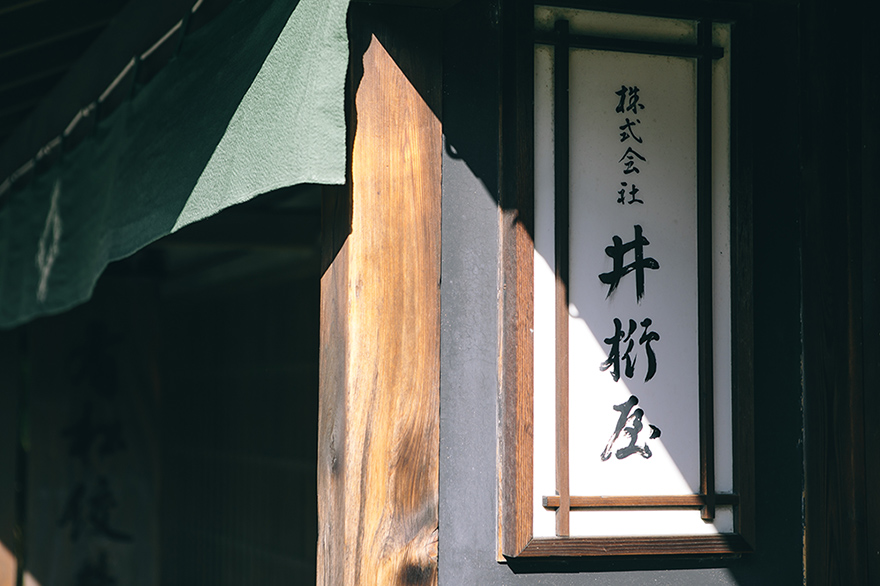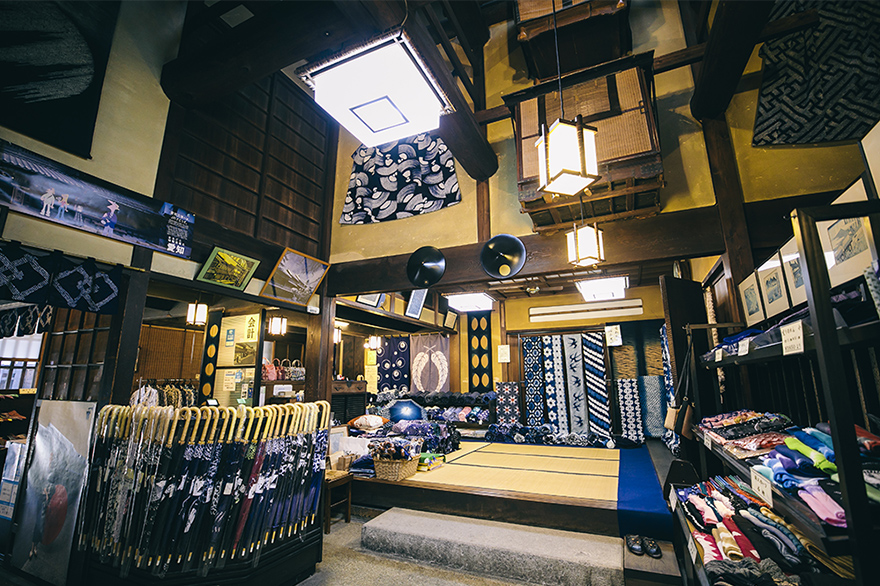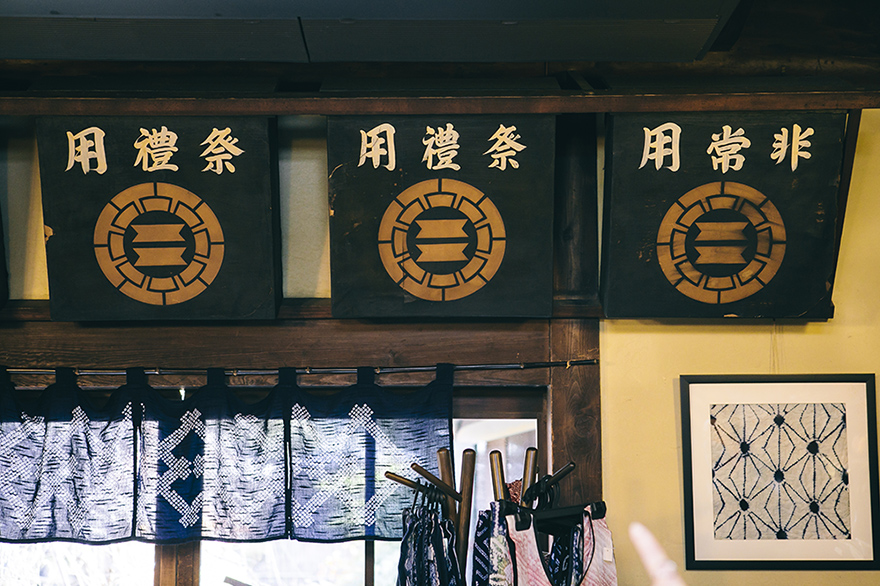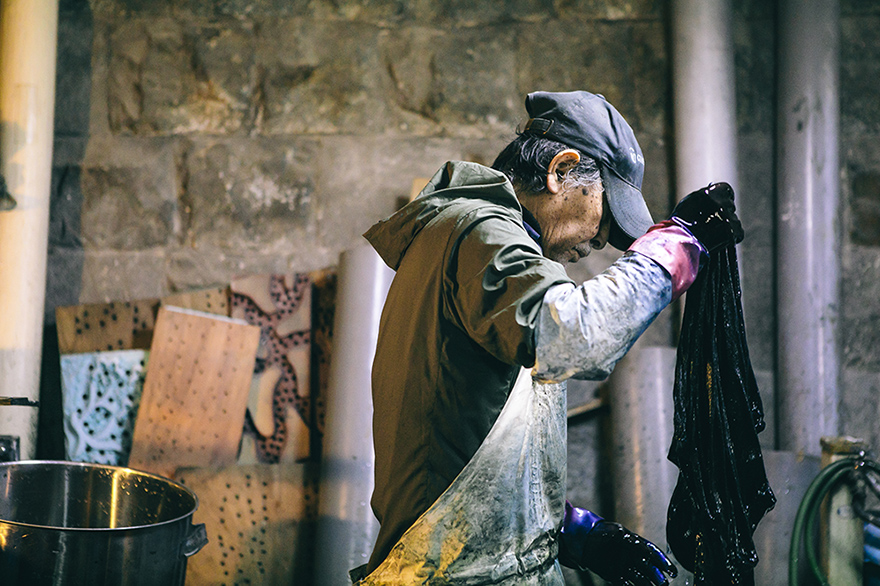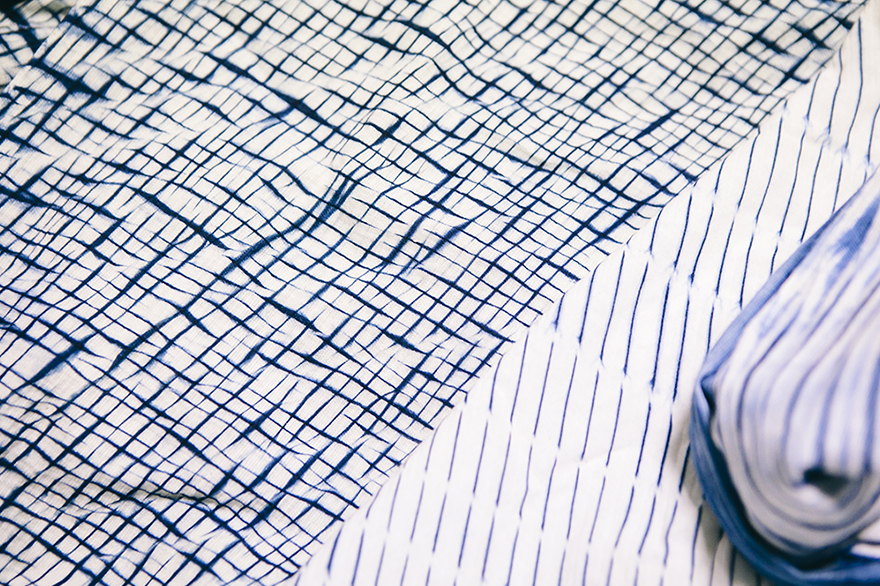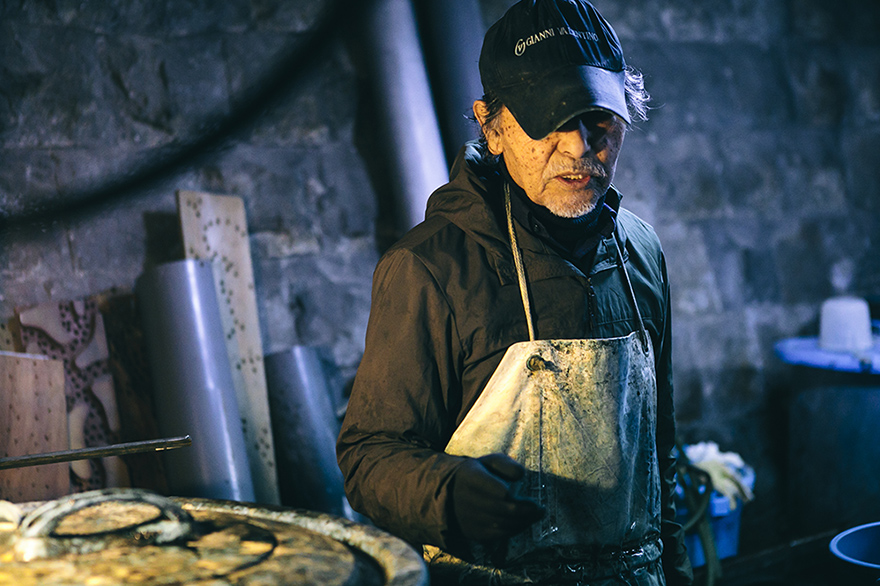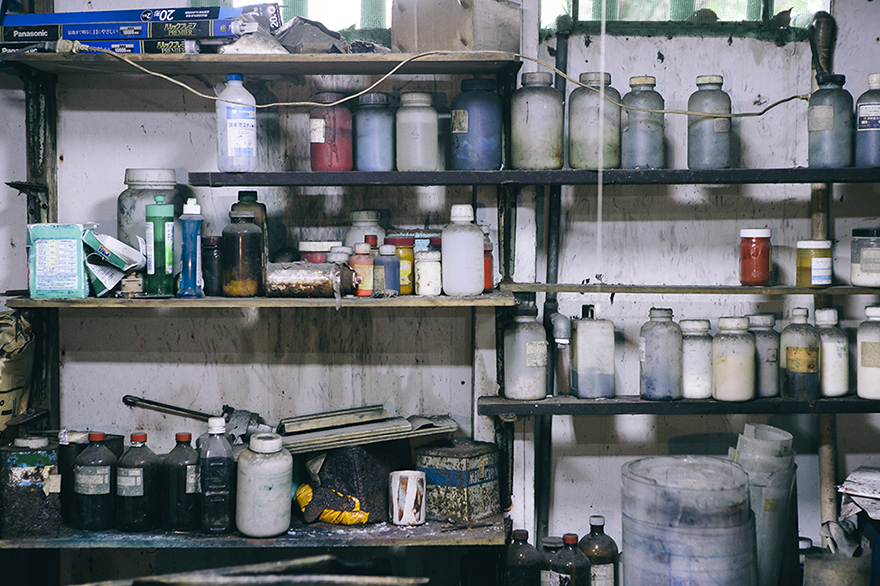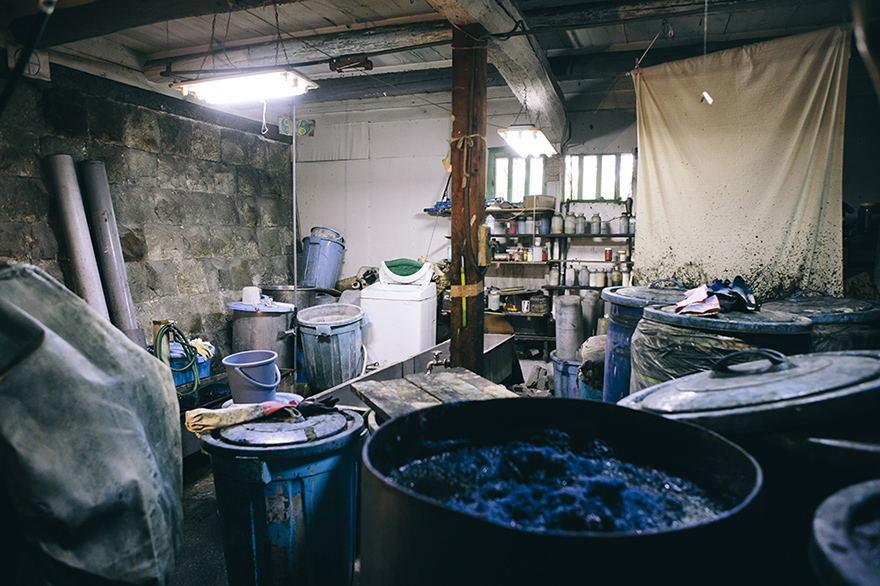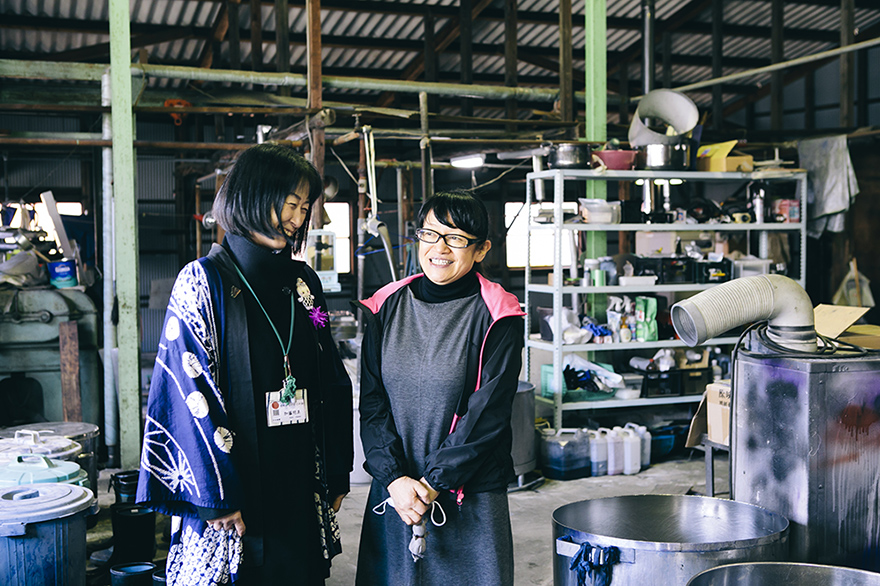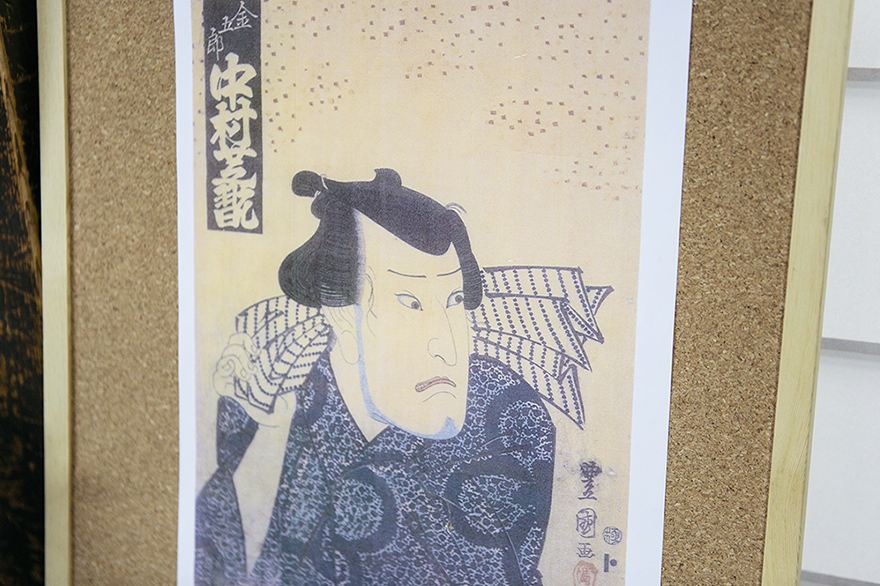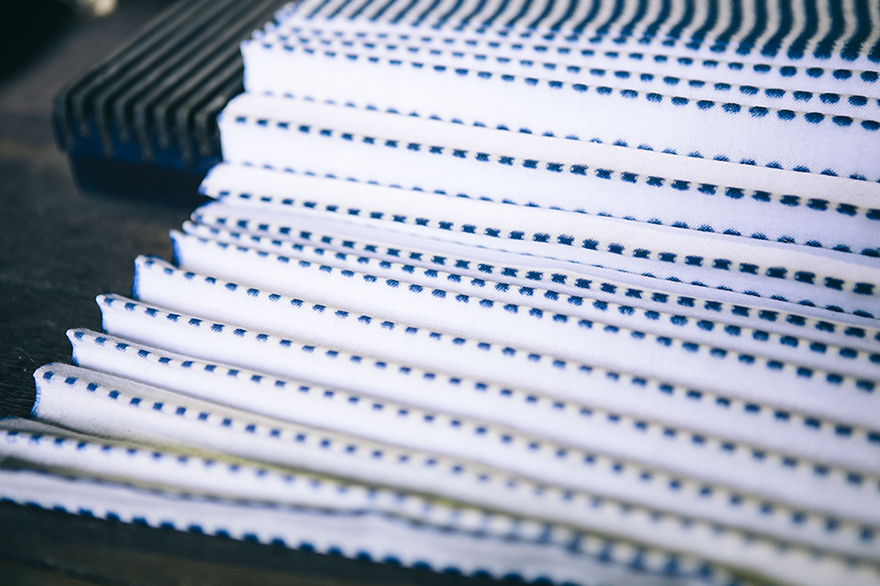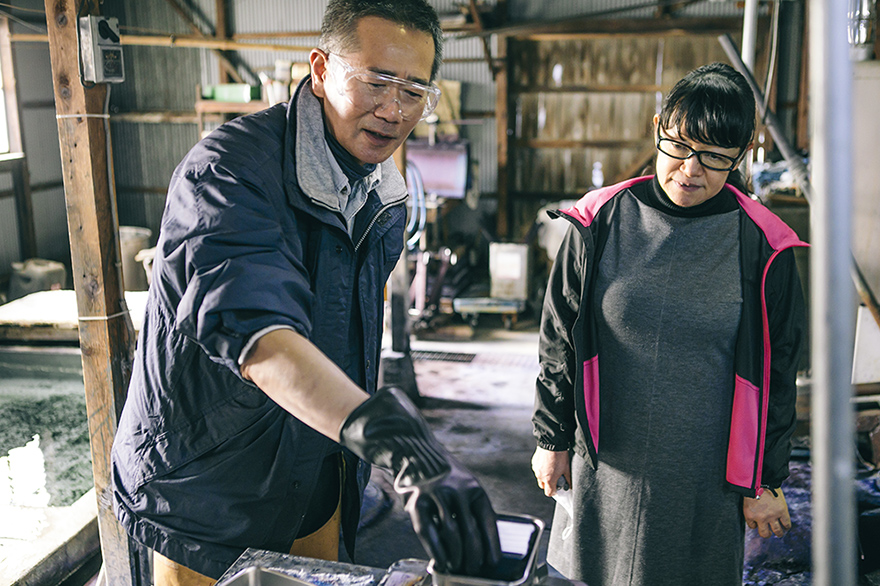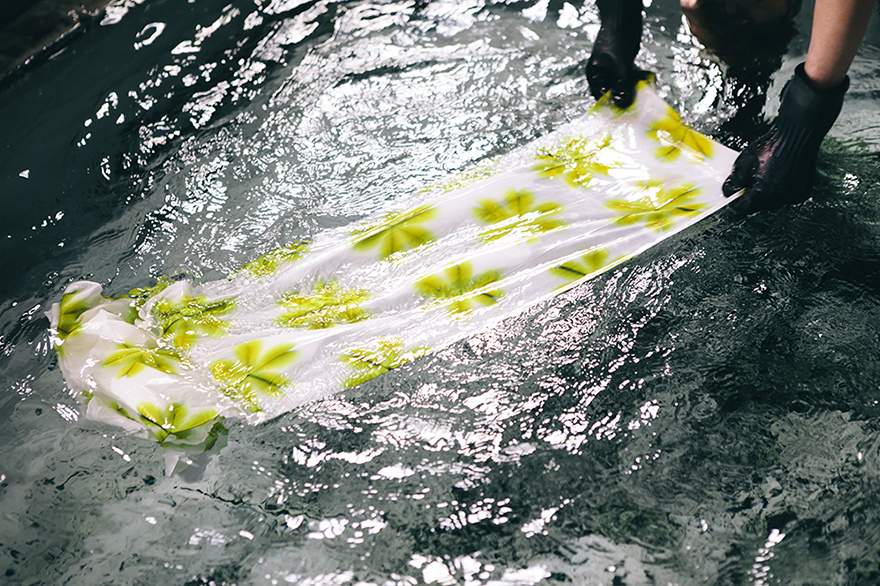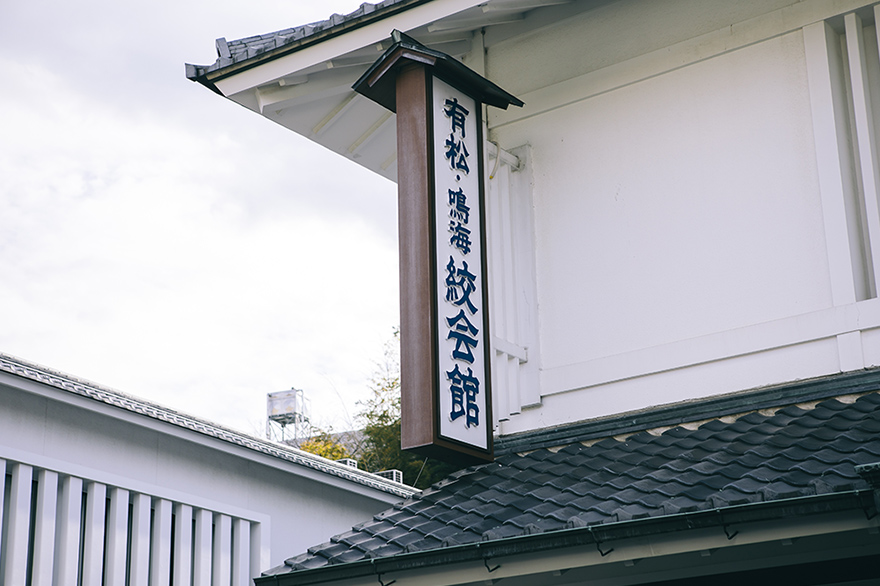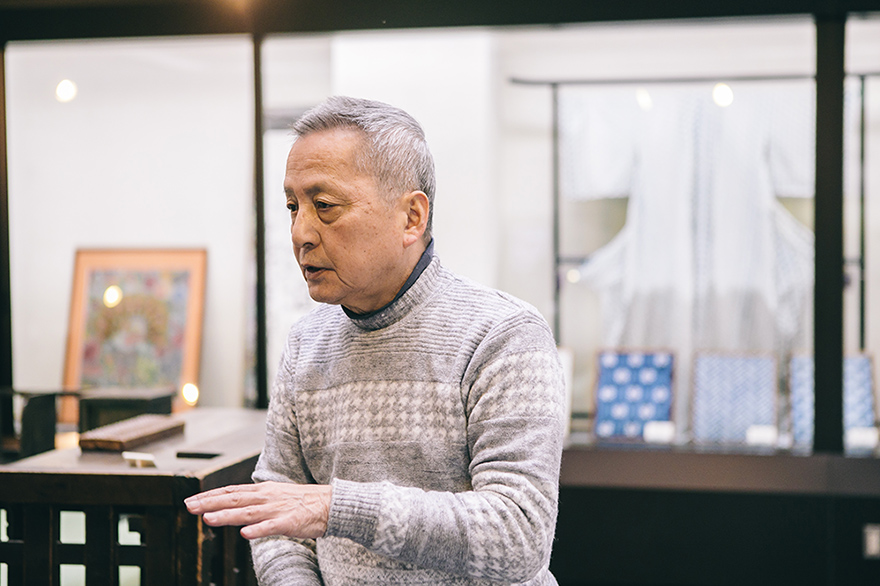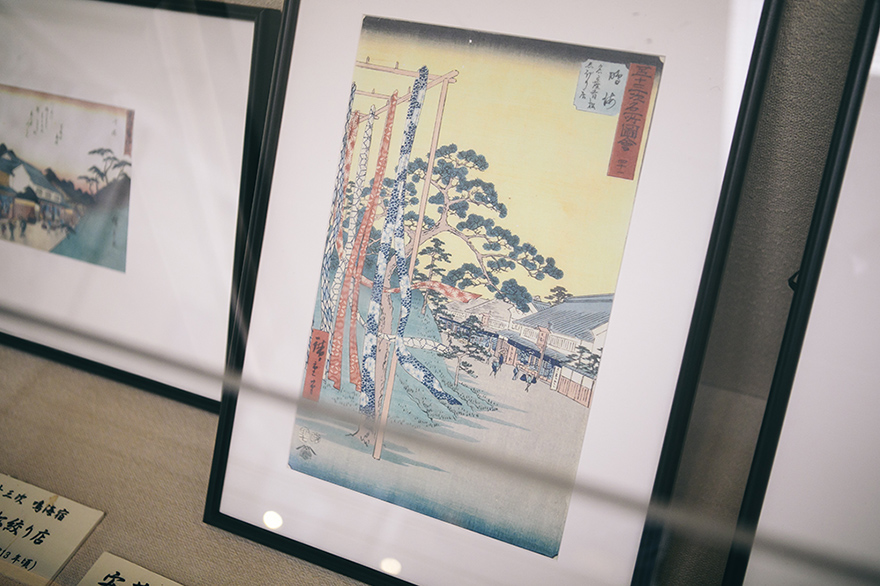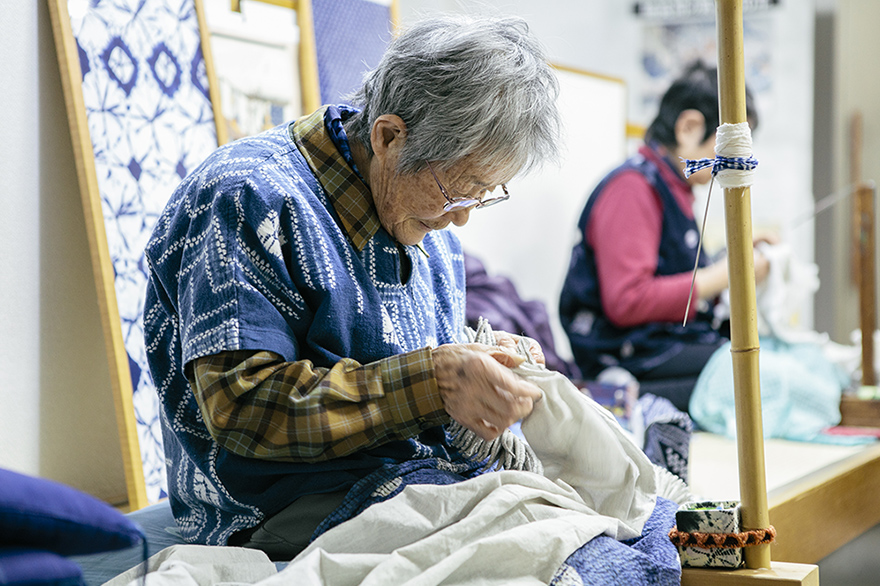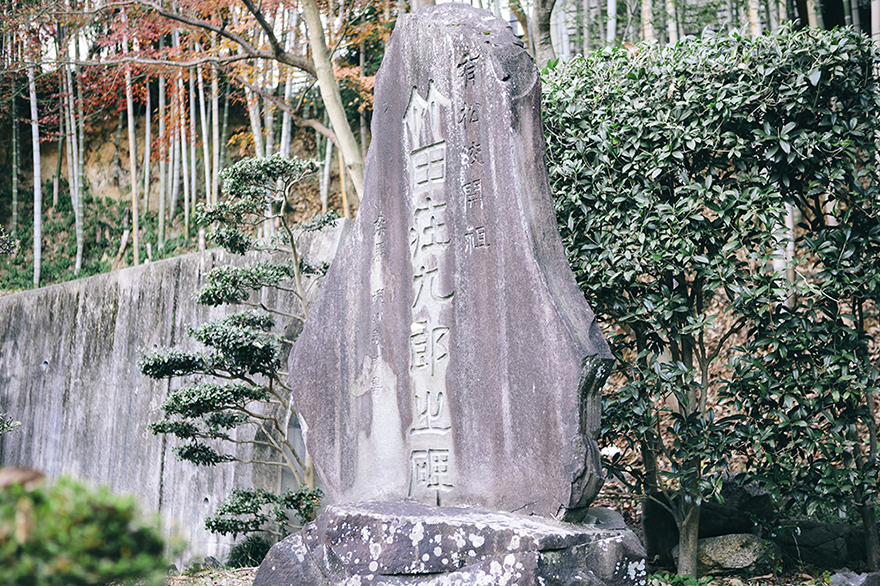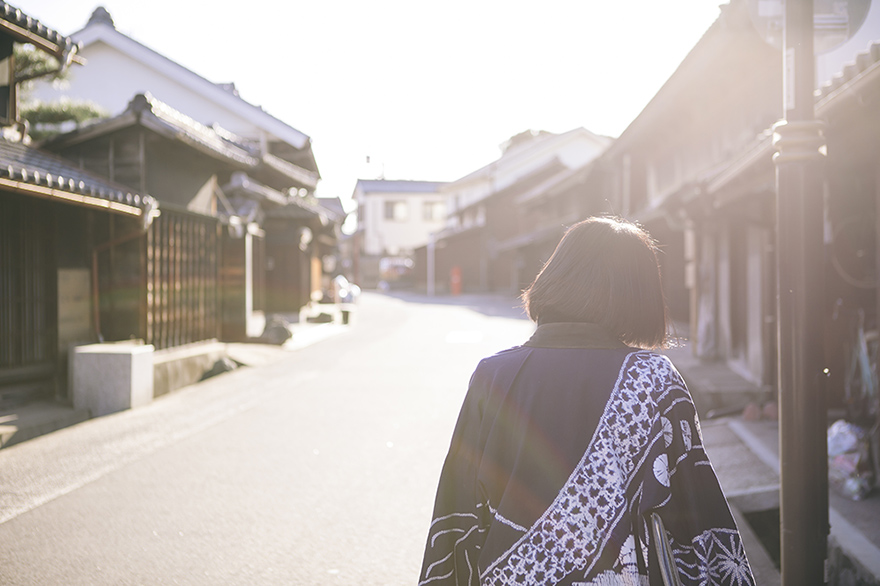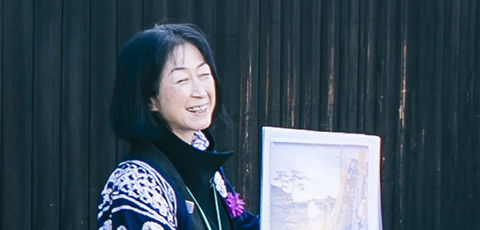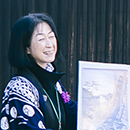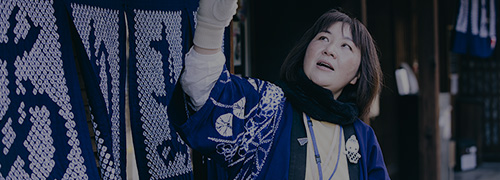Kato Akemi has worked as a tour guide since the founding of the Arimatsu Tour Guide Association 18 years ago. On this occasion, she’s showing us the history and traditional techniques of Arimatsu-Narumi tie-dyeing. Her words, full of love and respect for the town of Arimatsu and tie-dyeing, seem to bring fresh life to the profound appeal of tie-dyeing techniques that have been preserved without interruption since the Edo period. With the history of tie-dyeing on our mind, we set out on our walk through this town. Please come and join us.
The Tokaido Road, with the atmosphere of the tie-dyeing town
From Arimatsu Station to the Tokaido Road
When Akemi welcomes us, she is dressed just as she always is when she gives tours as a tour guide. The happi coat she is wearing was specially designed as a tour guide costume. It is vividly dyed in a rich indigo color and decorated with a number of tie-dyed patterns. We follow Akemi as she sets out at a brisk walk from Arimatsu Station, with the historical townscape our destination.
“The Tokaido Road is on the south side of the station. Do you see that the traffic signs at intersections along the road have their lights arranged vertically? That’s because parade floats come through here once a year during the autumn festival, and the lights are made this way to avoid collisions.”
On the way to the Tokaido Highway, we see a traffic signal with the lights arranged vertically. Akemi immediately tells us why Arimatsu is unique in having these.
This temple is deeply entrenched in the spirit of the people of Arimatsu, both past and present.
Gionji Temple
“When you reach the Tokaido Road, turn right and go straight. Our tour begins with Gionji Temple. This temple is very important to the people of Arimatsu as a family temple.”
Gionji Temple is depicted in the Owari Meisho Zue, a 19th-century illustrated guide to the Owari region’s famous sites, and the temple still retains a strong sense of the atmosphere of that era. It is a temple of the Buddhist Soto sect that was relocated from Endoji Temple in Narumi and erected here in 1755. It was used as a private elementary school during the Edo period.
“The main hall itself has been newly rebuilt, but the plaque above the door is from that period. The meaning of the three characters on the plaque is that this entrance is the final gate before you enter a holy place where a god resides. These characters appear in the Owari Meisho Zue as well.”
Tokugawa Yoshinao, a feudal lord who contributed to the development of the Arimatsu-Narumi tie-dyeing industry, and Suzuki Kinzo, who revived the art of tie-dyeing, are enshrined at Gionji Temple. Although it is a small temple, it still contains numerous valuable treasures.
“It isn’t open to the public, but these treasures include a statue of Akiba riding a white fox. Akiba is a fire prevention deity, and Arimatsu suffered a great fire that destroyed almost the entire town in 1784. This was extremely depressing for the people of Arimatsu at the time. Gionji Temple was one of the few buildings to survive the fire that burnt the town to the ground. Since then, the townspeople have vowed never to let another fire occur, and five shrines to Akiba remain in the town to this day.”
For the first 150 years after the town was founded, Arimatsu had no temple, so the wishes of the people came true when this long-awaited temple was finally built. The fact that Gionji Temple survived the fire was a source of great hope to the people of the town at that time. Additionally, the courtyard next to the main hall contains “the Stone of Buddha’s Footprints” modeled after the one at Yakushiji Temple in Nara and a monument with poetry composed by Empress Komyo.
“It says, ‘The echoes of stones that leave an impression reach up to heaven, and even the earth shakes, for the sake of the parents, for the sake of the people.’ This poem expresses the hope that our children and grandchildren can live in peace forever. You can see that it was a symbol of rebuilding by the people of Arimatsu at the time.”
The 33 Kannon Bodhisattva statues in one corner of the temple precincts were each donated by tie-dyeing merchants and dyers in Arimatsu after its rebuilding. Each of them is inscribed with the name of a shop from that era or the name of the people who donated it.
“After the great fire, Arimatsu was rebuilt in just 20 years thanks to the generous support of the Owari Domain. When I look at how the people contributed the Stone of Buddha’s Footprints and the Kannon Bodhisattva statues, I realize that even though prosperity returned to Arimatsu, the people of that era remembered to be thankful instead of focusing on personal gain. We tour guides also express our appreciation by cleaning it sometimes.”
The birth of Arimatsu as a tie-dyeing town
The origins of Arimatsu
There are several theories about the origins of the name “Arimatsu.” One is that before the Tokaido Road was built, the area was covered so densely with pines that it was dark even in the day, hence the name, which can be literally interpreted as “existence of pines” in Japanese. It is said that few people lived in this area before that time. In 1608, with the construction of the Tokaido Road, the Owari Domain issued a proclamation encouraging settlers to come and live here. Eight settlers saw the proclamation and established a village here, and that is how Arimatsu was born.
“It wasn’t until later that Arimatsu would become a thriving tie-dyeing town. The settlers tried farming at first, but the plentiful pines and clay soil made the land unsuitable for agriculture. They had no choice but to go and work at Nagoya Castle, which was under construction at the time. There, they happened to see tie-dyed tenugui hand towels carried by artisans who had come over from Kyushu. They realized they could apply the same technique to the cotton textiles from Chita, the town they were originally from, and go into business in Arimatsu selling souvenirs to travelers on the highway. And that’s where the idea to start tie-dyeing came from.”
Tie-dyed fabric, which wasn’t bulky and held up well over time, was the perfect souvenir for travelers, and it quickly became a hit product on the Tokaido Road. In a novel called Tokaidochu Hizakurige (Shank’s Mare), the character Yaji sings, “An Arimatsu tie-dyed tenugui hand towel is what I want! Even if I have to sell a kidney to afford it!” as he joyfully purchases a tie-dyed tenugui hand towel.
Yunoshi (steam-ironing) is a delicate manual technique that enhances the texture of tie-dyed fabric.
Yunoshi (steam-ironing) / Haribun
“When the Owari Domain saw Arimatsu thriving with the tie-dyeing business, they gave Arimatsu’s tie-dyeing merchants exclusive manufacturing and selling rights. Thanks in part to this, Arimatsu grew even more prosperous. That is how Arimatsu-Narumi tie-dyeing began. Even after 400 years, many of those techniques have been preserved with hardly any changes.”
Arimatsu-Narumi tie-dyeing is a resist dyeing technique. The process up to completion is generally divided into a number of specialized tasks. Following the processes of “mold carving” and “image printing”, a tie-dyeing artisan performs “knot tying”, and after that, the actual “dyeing” takes place. Another important step is yunoshi (steam-ironing), which is essential in order to bring out the best tie-dyeing results.
“Here at Haribun, they have been steam-ironing by hand since the days of the proprietor’s grandfather. We rarely get to see this process, but today they’re letting us take a special look, so let’s pay them a visit.”
At first glance, the house looks like an ordinary residence. Hanging from one of the eaves is a sign that says “Haribun”. Opening the sliding door and peering inside, we see a large space with an earthen floor that extends far to the back. Three women, including artisan Kato Kazuko, are working together on the steam-ironing process.
Ms. Kato briefly explains how it works: “Steam-ironing is done to the uncut fabric before the kimono is made. It takes at least three people to stretch out the fabric while high-temperature steam is applied from below, and since they are stretching an entire piece of fabric at a time, this cannot be done without a long work space. This is the optimal method to use in order to reproduce the beautiful wrinkles (crease pattern) that is unique to tie-dyed fabric, and it cannot be done with an iron that presses down from above.” There is also a machine-based method for doing the steam-ironing, but at Haribun, they are dedicated to the old-fashioned manual process, and they have kept the process alive all this time.
“Haribun was started by my grandfather, and I’m the third generation to run this business. It’s already been 40 years since I took over. I don’t think there’s any other place in Arimatsu that specializes in steam-ironing.”
Her tools have seen many years, and they have a dull luster that adds to their charm. They have been used since her grandfather’s day, but they are still in excellent working condition today.
“You can get scalded because of the hot steam. It takes a lot of effort, but this is the best way to preserve the texture without ruining the pattern and three-dimensional feel of tie-dyed fabric. The important thing is to make sure the width stays perfectly even. I’m very careful, because this will affect the final product that is made from it.”
A single piece of fabric requires three or four passes back and forth. Iron-steaming requires the fabric to be finished quickly in one go. In no time at all, the colors and patterns come to life, and the beautiful yukata fabric is ready. Performed by practiced hands, this manual technique comes to life through dedication and skill that require many years to develop.
Paying a visit to see the beauty and human workmanship of traditional tie-dyeing from the Edo period
House of Hattori (Igetaya)
After our visit to Haribun, we return to the Tokaido Road. Our next visit is to the House of Hattori (House of Hattori Magobei), which is located in nearly the center of the historical preservation district. This tie-dyed fabric wholesaler was established under the name Igetaya in 1790 after it branched off from Oigetaya, which was located on the other side of the Tokaido Road.
“Igetaya to this day still displays and sells large quantities of kimono cloth dyed with genuine indigo. This is the only place in Japan with such a large selection of indigo tie-dyed fabrics. They have a large variety of patterns, and its many customers come from far and wide.”
Inside the shop, we are welcomed by the proprietor, Hattori Kenji.
“We’ve been in business for nine generations since our founding in 1790. We used to be a wholesaler, but now we focus mainly on retail. As time has gone by and transportation has developed, the number of travelers on foot has dwindled. Instead, we are now expanding to sell to the entire country. We have a large selection of mainly indigo-dyed kimono fabrics in our tatami room. Even though our lives and our business have changed, tie-dyeing itself hasn’t changed much since the Edo period.”
It is tempting to focus our gaze on the array of kimono fabrics, but looking at the walls and ceiling, we see a sedan chair that has actually been used for weddings, a wooden box with the Igeta crest that was used to store lanterns, and other valuable objects that remind us of life in the past. These things are a must-see!
Fantastic storm-pattern tie-dyeing revived in the modern era
Kura-Kobo
There are said to be more than 100 Arimatsu-Narumi tie-dyeing techniques, in fact, but many of them have been discontinued for various reasons over the years. However, in the town of Arimatsu, there are people who have revived a fantastic technique that had once disappeared. We visited one of those people, Hayakawa Kaei.
Mr. Hayakawa is an artist from Arimatsu who has revived “storm-pattern” tie-dyeing, a technique that was once discontinued. Storm-pattern tie-dyeing is a bold technique that involves wrapping the fabric around a long round log, wrapping it with string or a rope, and pulling it to one side. Then the entire log is dipped in indigo dye to dye the fabric. As the name suggests, the crisp, vigorous patterns produced this way have a unique appeal that is well-suited to men’s yukatas.
“I don’t think there’s anyone else even in Arimatsu who would attempt something so foolish.”
Mr. Hayakawa started speaking quietly to us without stopping his work when we stopped by the workshop to see his work.
“To get a dark indigo color requires washing it at least ten times. As you can see, indigo dyeing is extremely labor-intensive. The dye made from indigo leaves is in short supply to begin with, and procuring it is difficult. On top of that, storm-pattern tie-dyeing is only possible if you have a large water tank to soak the long logs in. The amount of thread that can be dyed with a single pot at a time is 400 to 500 grams. It can be done about three times a day at most. Since a single t-shirt requires about 230 grams of thread, it’s not worth it at all. It wasn’t good for business, so eventually there was no one left doing it.”
It was about 20 years ago that Mr. Hayakawa began working in earnest to revive storm-pattern tie-dyeing. When asked about his motivation and dedication to this endeavor, he said, “Although I was born the eldest son of a dyer, I never expected to do it myself. However, I like making things, so I tried different things for about ten years, like expressing tie-dyeing patterns in glass and concrete. But I didn’t have some grandiose intention to restore storm-pattern tie-dyeing. Still, it was convenient for me that, unlike other tie-dyeing methods, this technique could be completed by a single person. While I was trying this and that, I decided to make a full-fledged attempt at restoring this technique; and if I was going to do it, I wanted to do it properly and use real indigo dye.”
At first, he tried using logs, which are essential for storm-pattern tie-dyeing, in the traditional, time-consuming manner by using hand-shaven Kitayama cedar trees harvested in the mountains, but now, he uses stainless steel pipes that are easier to handle and uniform in thickness instead. Through his ingenuity, Mr. Hayakawa has brought his own version of the fantastical storm-pattern tie-dyeing technique back to life.
“In my youth, I was so eager to find new forms of expression that I was willing to destroy tradition. But I realized that to express something new, I needed to return to my origins. I reviewed tie-dyeing techniques that emerged in Arimatsu during the Edo period as well as their origins to see what I could learn from them. That’s the true nature of craftsmanship. I still want to find something that makes me say, this is the one! I’m going to keep at it until I discover that thing.”
This shop carries on the passion of its predecessors, who reproduced traditional polka dot tie-dyeing.
Harisho
Polka dots are rows of countless dots arranged in a regular pattern. They are familiar as a common traditional pattern used for tenugui hand towels and similar products, but today, Harisho in Arimatsu is the only place in Japan that still dyes fabric with this pattern. Harisho was founded in 1897. It is a venerable dyer’s shop that specializes in the itajime (board-fastened) tie-dyeing method, which includes snowflake-pattern tie-dyeing and Katano-pattern tie-dyeing. Mr. and Mrs. Ukai are the shop’s fourth generation of proprietors, and they keep the traditional techniques alive. Mr. Ukai’s father and grandfather focused on polka dots, which had fallen out of use after the war. It took them five years to restore this pattern, and they completed it around the end of the 1950s or early 1960s.
“In 1950, a newspaper ran an article called ‘The Illusory Polka Dot’. Evidently, polka dots fell out of use because of the war. A towel shop in Osaka saw that article and contacted Takeda Kahei Shop, a wholesaler, asking if polka dot fabrics were made in Arimatsu, which led to a request for us to manufacture some.”
The polka dot tie-dying restored by Harisho is a type of itajime tie-dyeing. With this technique, cloth is folded accordion-style until it is about 2 cm wide and then sandwiched between two boards. Dye is poured into narrow grooves carved into the boards, and only the portion of the cloth touching the grooves is dyed, so that when it is unfolded, a regular pattern of dyed dots is the result. However, at the time, there were no records of how this pattern had been produced, and they didn’t even have a single tenugui hand towel dyed in the polka dot pattern. Sayuri, Mr. Ukai’s wife, says that the visionary attempt to restore this pattern must have been very hard work.
“We know this pattern had been around since the Edo period, because it’s depicted in numerous ukiyo-e woodblock prints and kabuki actor paintings. I think my grandfather and father went through a lot of trial and error. It all started at a beach in Minamichita. I’ve heard that rapid progress to restore the pattern was made after a chance encounter with someone who had a polka dot tenugui hand towel at the beach and showed it to them.”
Everything, including the tools, was made by hand, and the technique was reproduced perfectly. Numerous polka dot prints have become available recently, but in the world of kabuki and other traditional performing arts, hand-dyed fabrics are a must, so orders continue to come in.
“The beauty of this method is that each dot has its own character. My father was a ‘watch and learn’ kind of person, so he never gave me a detailed explanation. The folding and fastening are dependent on instincts developed over many years. The fabric also varies, and the season and the weather also have an effect. Both of us continue our trial and error every day.”
The three large tanks filled with well water that is abundantly available have been in use since the company was founded. Proprietor Keiichi sometimes takes time away from his busy work at Harisho to give demonstrations of snowflake-pattern tie-dyeing to customers who come in to see the workshop.
Be captivated by the brilliant handiwork of the artisans! Everything about tie-dyeing can be found here.
Arimatsu-Narumi Tie-Dyeing Museum
“I think it’s so amazing whenever I hear stories like this from the artisans. But we probably still don’t fully understand just how amazing it is. The more I learn about the history of our ancestors’ wisdom and hard work, the more I am always impressed.”
Soaking up the lingering sensation of excitement, Akemi took us to our last stop, the Arimatsu-Narumi Tie-Dyeing Museum. There, we listened to what Narita Motoo, president of the Commerce and Industry Cooperative of Arimatsu Tie-Dyeing, had to say.
“This museum opened in 1984 to introduce people to tie-dyeing, the traditional industry of Arimatsu. The gift shop on the first floor features goods made from tie-dyed fabric. The second floor has an exhibition room that displays cloth with typical tie-dyeing patterns as well as the various tools used for tie-dyeing. There are also some incredibly valuable items that are no longer in use, but they are still a small part of our collection. Scenes of Arimatsu and tie-dyeing patterns appear frequently in ukiyo-e woodblock prints, which tells us that tie-dyeing was incredibly popular in those days. In the exhibition room, we also play a movie showing the tie-dyeing process in an easy-to-understand manner. Everyone who goes by it stops in order to watch it intently.”
The best thing in the museum to see is the demonstration by active tie-dyeing artisans. That section of the museum is always popular, because you get to chat with the artisans and see their skillful craftsmanship up close.
“Although many of the active artisans are now advanced in years, they are still actively working and are very proud of their respective skills that they have inherited. It’s also fun to listen to those artisans speak the authentic Nagoya dialect.”
We remember our ancestors who pioneered this town and laid the foundation for its prosperity.
Takeda Shokuro Monument / Suzuki Kinzo Monument
At the back of the Arimatsu-Narumi Tie-dyeing Museum are monuments to Takeda Shokuro, the originator of Arimatsu tie-dyeing, and Suzuki Kinzo, who revived the art of tie-dyeing. A memorial service is held at the monuments each year to honor their achievements.
Did you enjoy our walk around Arimatsu, assisted by tour guide Kato Akemi? Rather than fading with time, the tradition of tie-dyeing and the historical townscape associated with it continue to be cherished. Arimatsu has been designated a Japan Heritage site. Its deep appeal continues to be evaluated, and you probably cannot really get a feel for the town without actually visiting it and experiencing it firsthand. It’s a leisurely 20-minute train ride from Nagoya Station. You should take a short trip to Arimatsu to see it for yourself and savor the atmosphere here.
PROFILE
Guide:
Kato Akemi
A founding member of the Arimatsu Tour Guide Association, Kato Akemi has worked as a tour guide for 18 years. She desires to convey the spirit and pride of the people of Arimatsu, including the historical townscape, the people, and the culture that have survived here since ancient times. She is a sincere guide who speaks lovingly about all things and touches the hearts of travelers.
This website shows you tie-dyeing activities that you can enjoy in Arimatsu.
